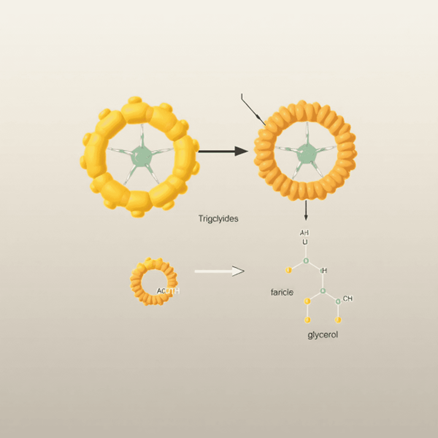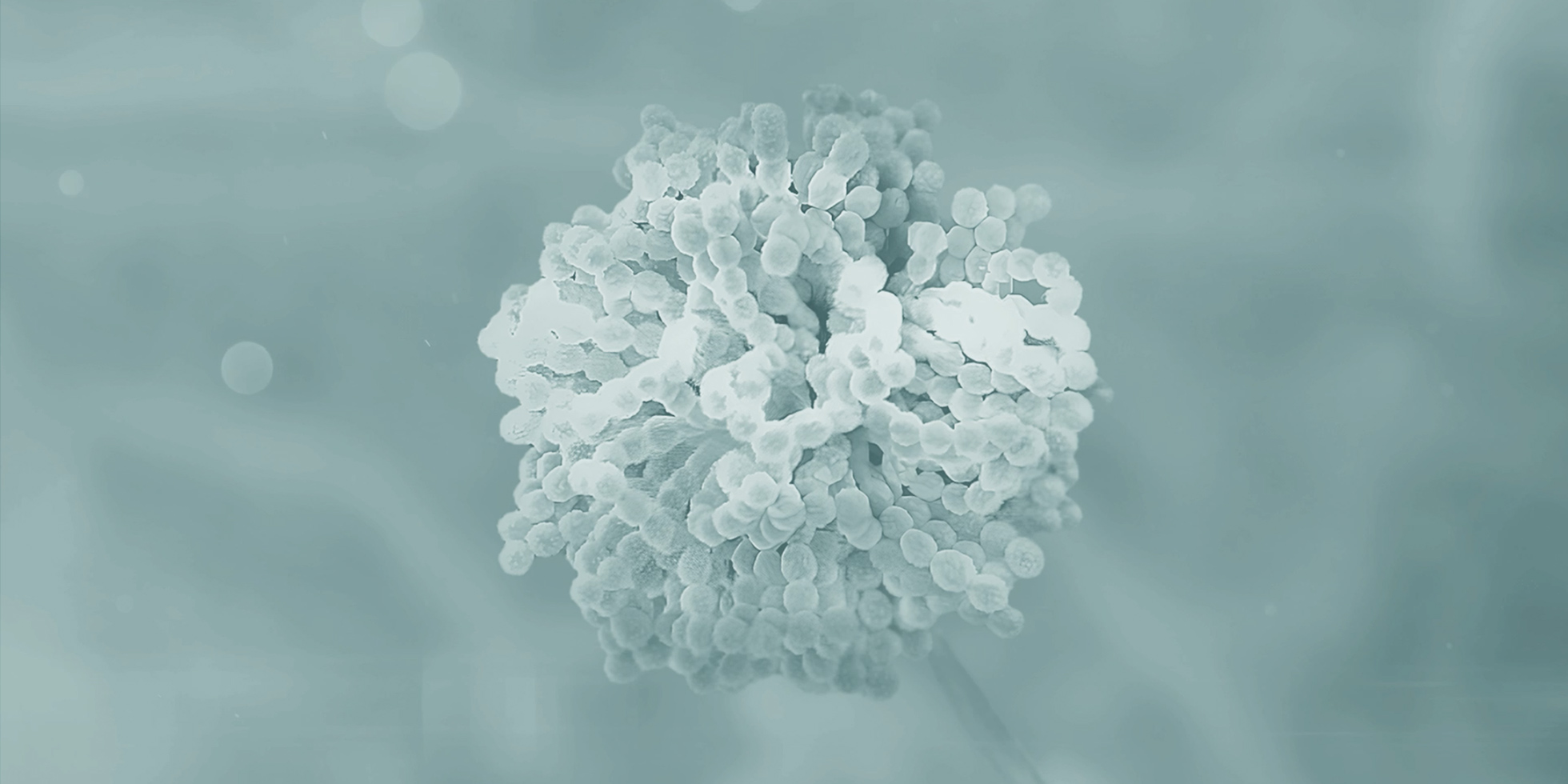Introduction
Lipases are important enzymes in living organisms that help break down complex fats into simpler substances. They do this by speeding up a chemical reaction called hydrolysis, where triglycerides (the main form of fat in our diet) are split into fatty acids and glycerol.

Figure 1: Basic lipase enzyme mechanism showing the breakdown of triglycerides into fatty acids and glycerol
In our digestive system, lipases produced primarily in the pancreas play a crucial role in processing dietary fats. Without these enzymes, our bodies would have difficulty absorbing essential fatty acids and fat-soluble vitamins.
Characteristics of Lipases
These remarkable enzymes have specific molecular features:
- Molecular weight: 19–60 kDa
- Optimal pH range: 4.0–8.0
- Optimal temp range: 25-50℃
Functional Mechanisms and Regulation of Lipase Activity
Lipase catalysis occurs through a unique mechanism at lipid-water interfaces. The enzyme’s active site contains a catalytic triad of serine, histidine, and aspartate residues that work together to break ester bonds. This process involves:
- Formation of an acyl-enzyme intermediate
- Release of alcohol product
- Hydrolysis of the intermediate
- Release of fatty acid product
Sources and Production of Lipases
Lipases come from three main sources:
1. Microbial Sources
These include microorganisms such as:
- Bacterial: Pseudomonas aeruginosa, Bacillus subtilis
- Fungal: Penicillium species, Aspergillus niger
- Yeast: Candida rugosa
Advantages of microbial lipases:
- High stability across different pH levels
- Ability to withstand high temperatures
- Higher yield production
- Rapid microbial growth
- Simplified purification processes
2. Animal Sources
Primarily from pancreatic and gastric lipases. For example, sources include the gullet of lambs and calves, as well as the pancreas of cows and pigs.
3. Plant Sources
Includes seed lipases and latex-based lipases. For example, seed sources include sunflower, pumpkin, and soybean, while latex sources include papaya and frangipani.
Fermentation Methods for Microbial Lipase Production
1. Submerged Fermentation (SmF)
In this method, the fermentation process takes place in a liquid medium. It offers benefits such as:
- Ease of controlling environment for optimal growth conditions
- Suitable for large-scale production compared to solid-state fermentation
- Easier monitoring of parameters like temperature and pH
2. Solid-State Fermentation (SSF)
Solid-state fermentation involves using solid substrates for microbial growth. This method has its own advantages:
- Lower energy requirements compared to submerged fermentation
- Reduced waste production during the process
- Higher concentration yields of lipase enzyme
Genetic Engineering Techniques for Enhanced Lipase Production
Advancements in genetic engineering have opened up new possibilities for improving lipase production. Some techniques being employed include:
- Gene cloning to introduce specific genes into microorganisms
- Protein engineering to modify existing lipase proteins for better performance
- Directed evolution to create variants with desired traits through random mutations
- Expression system optimisation to enhance the expression of lipase genes in host organisms
These approaches allow researchers to create customised lipases with enhanced stability, specificity, and production yields tailored for specific industrial applications.
Applications of Lipase Enzymes Across Industries
Lipase enzymes demonstrate remarkable versatility across multiple industrial sectors, revolutionising production processes and product development.
Food Industry Applications
- Dairy production – accelerating ripening processes of cheese
- Bakery products – improving dough stability and texture
- Structured lipids synthesis for enhanced nutritional value
- Production of flavours and fragrances
- Fat modification for functional food ingredients
Pharmaceutical Industry Impact
- Drug delivery system optimisation
- Synthesis of optically pure compounds
- Production of speciality chemicals
- Development of indigestion medicine
- Bioactive compound synthesis
Industrial Applications
- Detergent formulations for effective fat stain removal
- Leather processing enhancement
- Cosmetic ingredient production
- Paper and pulp industry treatments
- Biofuel production through transesterification
Lipase technology has transformed manufacturing efficiency, enabling higher product quality and cost-effective production through precise enzymatic control.
The Versatility of Lipases in Food Processing and Flavour Development
Lipases are powerful catalysts used in food processing to transform raw ingredients into enhanced products by specifically modifying fats. These enzymes excel at:
1. Texture Enhancement
- Breaking down complex fats into fatty acids and glycerol
- Creating smoother mouthfeel in chocolate products
- Improving dough strength in baked goods
2. Shelf-Life Extension
- Preventing lipid oxidation in processed foods
- Reducing rancidity in oils and fats
- Stabilising emulsions in sauces and dressings
3. Flavour Development
- Accelerating cheese ripening through fat hydrolysis
- Producing distinct flavour compounds in fermented dairy
- Creating unique taste profiles in beverages
Lipases play a vital role in developing speciality fats for confectionery, releasing short-chain fatty acids that contribute to distinctive aromas. In dairy processing, these enzymes generate compounds responsible for the characteristic flavours in aged cheeses, butter, and yoghurt.
The selective hydrolysis capabilities of lipases enable precise control over fat modification, allowing food manufacturers to achieve specific sensory properties while maintaining product stability. This enzymatic precision has revolutionised the production of reduced-fat alternatives and functional food ingredients.
Recent Advances in Lipase Technology
Cost-Effective Production
Research breakthroughs have transformed lipase production through cost-effective methods using agro-industrial waste as fermentation media alternatives. Scientists now use:
- Rice bran
- Wheat straw
- Sugarcane bagasse
- Oil cakes
These materials act as nutrient-rich environments for microbial growth, lowering production costs by up to 40%.
Immobilisation Innovations
New techniques have improved industrial enzyme stability and reusability:
- Nano-carrier systems (magnetic particles)
- Sol-gel entrapment
- Cross-linked enzyme aggregates (CLEAs)
These systems allow up to 20 reuse cycles and maintain 85% activity, with extended tolerance across 10–80°C and pH 4–9. Smart materials also enable continuous flow processes in bioreactors.
Challenges and Future Perspectives in Lipase Research
Stability Under Industrial Conditions
Lipases can denature under extreme pH or high temperatures. Current solutions include:
- Site-directed mutagenesis for thermostability
- Structural modifications for pH resilience
- Creation of hybrid enzymes
Environmental Sustainability Advances
Efforts include:
- Replacing chemical catalysts
- Lowering energy consumption
- Reducing toxic by-products
Green chemistry principles focus on:
- Biodegradable products
- Reduced solvent usage
- Lower carbon footprint
- Water conservation
Artificial intelligence and machine learning are accelerating the design of more robust enzyme variants.
Market Analysis and Global Outlook for Lipase Enzymes
The global lipase enzyme market is experiencing strong growth, with projections reaching USD 797 million by 2025. This significant expansion is driven by increasing industrial applications and technological advancements in enzyme production.
Regional Market Trends
- Europe: Market leader due to bio-based regulations and strong R&D
- North America: Growth in the pharmaceutical and food sectors
- Asia Pacific: Fastest-growing, driven by:
- National Dairy Development Program
- Expanding food and beverage industry
- Increased adoption of enzyme-based cleaning solutions
Different growth rates reflect regional industrialisation and policy factors.
Conclusion
Lipase enzymes are leading the way in sustainable industrial solutions, driving innovations in food processing, pharmaceuticals, and biotechnology. Their incredible versatility and environmentally friendly nature make them crucial in the global movement towards greener manufacturing.
Recent advancements in enzyme engineering, production methods, and application technologies have pushed the boundaries of lipase capabilities. The market for lipase-based solutions is projected to reach USD 797 million by 2025, indicating a growing acceptance of these solutions in various industries.
Moving forward, it is essential to continue exploring scientifically and implementing lipase technologies in industries. This will pave the way for a future where sustainable biocatalysis becomes the standard in manufacturing processes worldwide.
Explore Amano Enzymes solutions and let us help you implement lipase technology in your applications: Lipase Technology Solutions – Amano Enzyme Inc.
